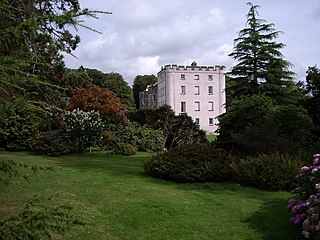Related Research Articles

Thomas Gage, 1st Viscount Gage of High Meadow, Gloucestershire and later Firle Place, Sussex, was a British landowner and politician who sat in the House of Commons as a Whig for 33 years between 1717 and 1754.
Viscount Tracy, of Rathcoole in the County of Dublin, was a title in the Peerage of Ireland. It was created on 12 January 1643 for Sir John Tracy, previously Member of Parliament for Gloucestershire. He was made Baron Tracy, of Rathcoole in the County of Dublin, at the same time, also in the Peerage of Ireland. The second Viscount also represented Gloucestershire in Parliament. The titles are considered to have become extinct on the death of the eighth Viscount in 1797. However, the peerages were the subjects of at least four claims presented to the House of Lords during the 19th century.

Charles Hanbury-Tracy, 1st Baron Sudeley, known as Charles Hanbury until 1798 and as Charles Hanbury Tracy from 1798 to 1838, was a British Whig politician.

Sir John St John, 1st Baronet of Lydiard Tregoze in the English county of Wiltshire, was a Member of Parliament and prominent Royalist during the English Civil War. He was created a baronet on 22 May 1611.

Sir Thomas Shirley, of Wiston in Sussex, was an English Member of Parliament, government official and courtier who is said to have suggested the creation of the title of baronet.
Thomas Eustace, 1st Viscount Baltinglass was an Anglo-Irish noble who achieved wealth and influence by prudently remaining loyal to the English Crown. He was born circa 1480 at Caslemartin, County Kildare.
Sir William Cooke of Highnam Court in Gloucestershire, was an English landowner and politician who sat in the House of Commons at various times between 1597 and 1614.
The Juxon Baronetcy, of Albourne in the County of Sussex, was a title in the Baronetage of England. It was created on 28 December 1660 for William Juxon. The title became extinct on the death of the second Baronet in 1740.
The Fust Baronetcy, of Hill in the County of Gloucester, was a title in the Baronetage of England. It was created on 21 August 1662 for Edward Fust, who had earlier fought as a Royalist in the Civil War. The title became extinct on the death of the sixth Baronet in 1779.
Sir Robert Tracy, 2nd Viscount Tracy was an English politician who sat in the House of Commons of England variously between 1620 and 1640. He fought for the Royalists in the English Civil War.
Sir Edward Stephens of Little Sodbury, Gloucestershire was an English lawyer and politician who sat in the House of Commons variously between 1640 and 1660.

Sir Oliver Cromwell was an English landowner, lawyer and politician who sat in the House of Commons at various times between 1589 and 1625. He was the uncle of Oliver Cromwell, the Member of Parliament, general, and Lord Protector of England.

Sir John Philipps, 1st Baronet was a Welsh landowner and politician who sat in the House of Commons in 1601.

William Brereton, 1st Baron Brereton was an English politician who sat in the House of Commons at various times between 1597 and 1622. He was created a peer in the Peerage of Ireland in 1624 as Baron Brereton.
Robert Tracy (1655–1735) was an English judge.
Sir Anthony Keck was an English lawyer and politician. He was a member of Parliament between 1691 and 1695, and served as Commissioner of the Great Seal from 1689 to 1690.
William Cooke, of Highnam Court, Gloucestershire, was an English politician. He was a Member (MP) of the Parliament of England for Gloucester in 1679 and 1689 to 1695.
The historic manor of Iron Acton was a manor centred on the village of Iron Acton in Gloucestershire, England, situated about 9 miles (14 km) north-east of the centre of the City of Bristol. The manor house, known as Acton Court is a Tudor building which survives today, situated at some distance from the village and parish church of St Michael. It was long the principal seat of the prominent Poyntz family, lords of the manor, whose manorial chapel is contained within the parish church.
Henry de la River of Tormarton in Gloucestershire was a Member (MP) of the Parliament of England for Gloucestershire in 1394.
Kinard de la Bere was an English landowner and MP. He was the son of John de la Bere of Southam, Gloucestershire and Anne, daughter of John Stephens of Lypiatt, Gloucestershire. The various branches of his mother's family frequently represented Gloucestershire in parliament. In 1699 he married Hester, the daughter and co-heiress of John Neale of Nether Dean, Beds. Her sister Anne had married his mother's nephew Thomas Stephens, a Whig MP for Gloucestershire from 1713 until his death in 1720. At the general election in 1722 he was returned to sit for Gloucestershire through the influence of the Stephens. He served only one term and did not stand in the following election. He died childess and his estate was inherited by his nephew William Baghot, who assumed the name De la Bere.
References
- ↑ "TRACY, Sir John II (c.1561-c.1648), of Toddington, Glos. | History of Parliament Online". historyofparliamentonline.org. Retrieved 18 May 2016.
- 1 2 3 "The parliamentary history of the county of Gloucester, including the cities of Bristol and Gloucester, and the boroughs of Cheltenham, Cirencester, Stroud, and Tewkesbury, from the earliest times to the present day, 1213-1898". 1898. Retrieved 18 May 2016.